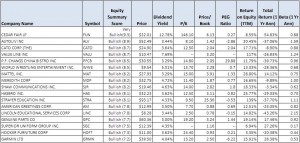S&P recommends overweighting the S&P 500 Consumer Discretionary sector. Year to date through November 18, the sector index, which represented 10.7% of the S&P 500 Index, was up 1.1%, compared with a 3.3% drop for the S&P 500. In 2010, this sector index rose 25.7%, versus a 12.8% advance for the 500. There are 32 sub-industry indices in this sector, with Restaurants being the largest at 14.3% of the sector’s market value.
S&P equity analysts’ fundamental outlook on the Consumer Discretionary sector is positive. S&P Economics forecasts U.S. real GDP growth of 1.7% in 2012, and sees consumer spending increasing 2.2%. We anticipate that thematic drivers in 2012 will include technology advances, continued international expansion, continued market segmentation of the targeted consumer base (demographic considerations, etc.), secular changes in consumer behavior (online vs. traditional), advances in digital media technology, and further shifts to ROI-driven audience aggregation. According to Capital IQ, the sector trades at a P/E of 13.1X consensus estimated 2012 EPS, which is greater than the S&P 500’s projected P/E of 11.3X. Its P/E-to-projected-five-year EPS growth rate (PEG) ratio of 0.9X is below the broader market’s 1.0X. The sector’s marketweighted STARS average of 3.8 (out of 5.0) is in line with the average of 3.8 for the S&P 500.
The S&P GICS Consumer Discretionary Index has completed a bullish, double-bottom reversal formation, so it appears to us that the correction is over. In addition, prices have jumped back above the bearish trendline that had been in place since the top in July, further confirmation, in our view, that the intermediate-term trend has turned bullish. However, prices have moved into a heavy layer of overhead supply that runs all the way up to the recent highs at 330, so the slope of the advance may become flatter as the sector tries to eat through this supply. Relative strength versus the S&P 500 recently hit a new bull market high. Our technical opinion on the Consumer Discretionary sector remains bullish.
In summary, S&P recommends overweighting the S&P Consumer Discretionary sector as strong emerging market revenue growth and a gradually expanding U.S. economy likely fuel above-average EPS growth, in our view, enabling market outperformance.
The individual stocks are shown in the table below. These are the highest ranking dividend stocks based on equity summary score provided by Fidelity Investments. The Equity Summary Score provides a consolidated view of the ratings of 10+ independent research providers on Fidelity.com. It uses the providers’ relative, historical recommendation performance along with other factors to give you an aggregate, accuracy-weighted indication of the independent research firms’ stock sentiment.
Cedar Fair (FUN) owns and operates amusement and water parks in the United States and Canada. FUN has a very bullish rating with a high dividend yield of 12.78%. This stock has been touted by Jim Cramer on Mad Money in recent weeks. It’s more of a turnaround stock as the consumer decides to do more enterteinment vis the themeparks in the U.S.
Autoliv, Inc. (ALV), is the leading supplier of safety parts for the auto industry. Products include seat belts, airbags, side-impact airbags, and electronics. Research and development is a vital part of the company’s strategy, as Autoliv regularly spends about 6% of sales to maintain a competitive advantage. Underscoring this notion, Autoliv holds 7% of all automotive safety patents. In 2010, total revenue was $7.2 billion, with U.S., European and Asian manufacturers accounting for roughly 30%, 30% and 40%, respectively. Autoliv has developed– and executes — a great business strategy. Its niche businesses are lucrative, and stable. Additionally, management has demonstrated that it operates in the best interest of shareholder value.
P.F. Chang’s (PFCH) owns and operates two restaurant concepts in the Asian niche. The Bistro chain consists of more than 200 full-service restaurants, which feature Chinese cuisine in a contemporary setting. Entrees at the Bistro range in price from $6 to $23, and the average check per guest is $20-$21. The Pei Wei concept, with 173 units, features a more modest menu of Asian cuisine, offering counter service and takeout food. The average check at Pei Wei is between $9 and $10. P.F. Chang’s PFCB reported weak third-quarter results, reflecting the tough environment restaurants are enduring. Although the near term will likely be rocky, we maintain our thesis that P.F. Chang’s is one of the more stable casual dining operators and holds a leading presence in the niche Asian dining segment. We think the firm is in good condition to withstand the fickle consumer environment, and we will be maintaining our fair value estimate. We believe the firm’s shares are currently undervalued.

